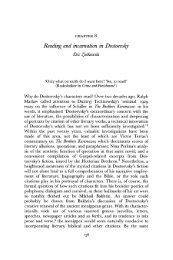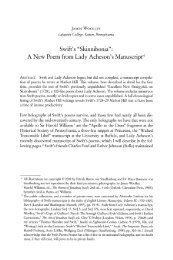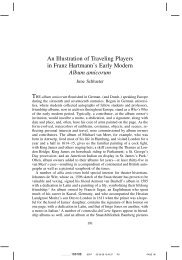courses of instruction - Lafayette College
courses of instruction - Lafayette College
courses of instruction - Lafayette College
Create successful ePaper yourself
Turn your PDF publications into a flip-book with our unique Google optimized e-Paper software.
The B.S. degree major requires a First-Year<br />
Seminar, English 110, and Values and<br />
Science/Technology (VAST) seminar; five<br />
<strong>courses</strong> in Mathematics including 161,162,<br />
263,264; two <strong>courses</strong> in Chemistry, Biology,<br />
or Geology from a selected list; 13 <strong>courses</strong><br />
in Physics with the restrictions and excep<br />
tions noted below; and three <strong>courses</strong> in<br />
Humanities/Social Sciences.<br />
The standard B.S. degree requires 11<br />
<strong>courses</strong>: Physics 121 (or 131), 122,132,<br />
215, 216, 218, 327, 335, 338, 342, and 351.<br />
However, in special circumstances, stu<br />
dents who have taken advanced Electrical<br />
and Computer Engineering or Mechanical<br />
Engineering <strong>courses</strong> in electromagnetic<br />
theory, electronics, dynamics, or thermo<br />
dynamics may be permitted to waive the<br />
requirement <strong>of</strong> certain <strong>of</strong> these required<br />
<strong>courses</strong>. This requires the approval <strong>of</strong> the<br />
head <strong>of</strong> the Physics Department and the<br />
Academic Progress Committee. Also, ad<br />
vanced <strong>courses</strong> from other science or engi<br />
neering departments may be substituted<br />
for Physics elective <strong>courses</strong> and up to two<br />
required Physics <strong>courses</strong> with the approv<br />
al <strong>of</strong> the head <strong>of</strong> the Physics Department<br />
and the Academic Progress Committee,<br />
when doing so will produce a coherent<br />
program <strong>of</strong> physics applied to an interdis<br />
ciplinary field such as material science,<br />
biophysics, geophysics, etc.<br />
Requirements for the minor: The minor<br />
consists <strong>of</strong> six <strong>courses</strong>, including Physics<br />
121 (or 131), 122 or 132,215, and three oth<br />
er <strong>courses</strong> approved by the department.<br />
104. Planetary Astronomy. An introduc<br />
tion to the study <strong>of</strong> the planets and their<br />
major satellites as large geological worlds<br />
to explore. Up-to-date information on the<br />
surfaces, atmospheres, and interior struc<br />
tures <strong>of</strong> these bodies as well as informa<br />
tion on asteroids, comets, meteorites, and<br />
the Sun is presented. The elementary<br />
physics <strong>of</strong> gravity, orbits, and distance<br />
measurement leads to a limited amount <strong>of</strong><br />
problem solving. Six biweekly laboratory<br />
sessions and at least three observing ses<br />
sions with telescopes. This is a non-mathe<br />
matical course (requiring only high school<br />
PHYSICS<br />
algebra and trigonometry) that satisfies<br />
the A.B. lab science requirement. Offered<br />
in fall semester. Mr. Hogenboom<br />
106. Physics <strong>of</strong> Music. A study <strong>of</strong> the phys<br />
ics <strong>of</strong> musical sound and musical instru<br />
ments: wave motion and sound, sound syn<br />
thesis, room acoustics, woodwinds, brasses,<br />
strings, piano, percussion, and the human<br />
voice. Open to all students but specifically<br />
intended for those who have not previously<br />
studied physics. Lecture/laboratory. Satis<br />
fies the A.B. lab science requirement. Offered<br />
in spring semester, even years. Mr. H<strong>of</strong>fman<br />
108. Cosmology: The Big Bang. A study<br />
<strong>of</strong> theories <strong>of</strong> the evolution <strong>of</strong> the uni<br />
verse, stressing modern cosmology as an<br />
observational science. Evolution <strong>of</strong> stars<br />
and galaxies, dark matter, evidence for the<br />
Big Bang model, history <strong>of</strong> the universe.<br />
Open to all but specifically intended for<br />
those who have not previously studied<br />
physics. One evening telescope observing<br />
session. Lecture/laboratory. Satisfies the<br />
A.B. lab science requirement. Offered one<br />
semester, alternate years. Mr. H<strong>of</strong>fman<br />
111. General Physics Mechanics and<br />
Thermodynamics. Classical mechanics <strong>of</strong><br />
particles and rigid bodies; laws <strong>of</strong> thermo<br />
dynamics with emphasis on microscopic<br />
foundation; oscillations and waves. Physi<br />
cal ideas are stressed, but considerable em<br />
phasis is placed on problem solving. To<br />
gether with Physics 112, this course satisfies<br />
requirements for medical school, B.S. ma<br />
jors in biology and computer science, and<br />
A.B. majors in biology, chemistry, geology,<br />
and engineering, but not B.S. majors in en<br />
gineering, chemistry, geology, or physics.<br />
Requires high school algebra and trigonom<br />
etry; Mathematics 125 is recommended.<br />
Satisfies the A.B. lab science requirement.<br />
Offered in fall semester. Mr. Dougherty<br />
112. General Physics Electricity, Mag<br />
netism, and Optics. Electric and magnetic<br />
fields; electromagnetic induction; electric<br />
circuits; geometrical and physical optics;<br />
Einstein's special theory <strong>of</strong> relativity;<br />
foundations <strong>of</strong> quantum mechanics; and<br />
nuclear physics. Physical ideas are<br />
155











